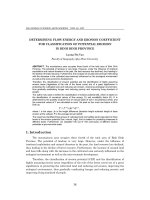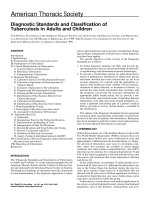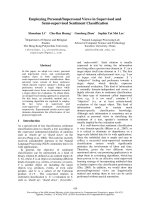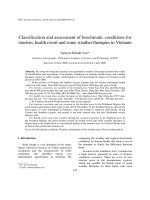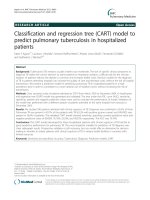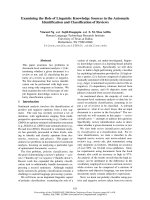Classification and Regression In a Weekend Classification and Regression In a Weekend
Bạn đang xem bản rút gọn của tài liệu. Xem và tải ngay bản đầy đủ của tài liệu tại đây (839.74 KB, 75 trang )
Classification and Regression: In
a Weekend
By
Ajit Jaokar Dan Howarth
With contributions from
Ayse Mutlu
Follow me on LinkedIn for more:
Steve Nouri
/>
Contents
Introduction and approach ___________________________________ 4
Background ___________________________________________ 4
Tools ________________________________________________ 6
Philosophy ____________________________________________ 8
What you will learn from this book? ________________________ 9
Components for book ______________________________________ 11
Big Picture Diagram ________________________________________ 13
Code outline _____________________________________________ 15
Regression code outline ________________________________ 15
Classification Code Outline ______________________________ 16
Exploratory data analysis ___________________________________ 16
Numeric Descriptive statistics ____________________________ 16
Graphical descriptive statistics ___________________________ 18
Analysing the target variable _____________________________ 22
Pre-processing data ________________________________________ 22
Dealing with missing values ______________________________ 22
Treatment of categorical values __________________________ 23
Normalise the data ____________________________________ 23
Split the data _____________________________________________ 27
Choose a Baseline algorithm _________________________________ 30
Defining / instantiating the baseline model _________________ 30
Fitting the model we have developed to our training set _______ 30
–3–
Ajit Jaokar – Dan Howarth
Define the evaluation metric _____________________________ 31
Predict scores against our test set and assess how good it is ____ 33
Evaluation metrics for classification ___________________________ 33
Improving a model – from baseline models to final models_________ 38
Understanding cross validation ___________________________ 39
Feature engineering ___________________________________ 42
Regularization to prevent overfitting ______________________ 42
Ensembles – typically for classification _____________________ 45
Test alternative models _________________________________ 46
Hyperparameter tuning _________________________________ 47
Conclusion _______________________________________________ 48
Appendix ________________________________________________ 51
Regression Code ______________________________________ 51
Classification Code _____________________________________ 64
Introduction and approach
Background
This book began as a series of weekend workshops created by Ajit
Jaokar and Dan Howarth in the “Data Science for Internet of
–4–
Things” meetup in London. The idea was to work with a specific
(longish) program such that we explore as much of it as possible in
one weekend. This book is an attempt to take this idea online. We
first experimented on Data Science Central in a small way and
continued to expand and learn from our experience. The best way to
use this book is to work with the code as much as you can. The code
has comments. But you can extend the comments by the concepts
explained here. The code is
Regression
/>s2dd0M4Gr1y1W
Classification
/>
This document also includes the code in a plain text format in the
appendix. The book also includes an online forum where you are
free to post questions relating to this book link of forum
Community for the book
/>Finally, the book is part of a series. Future books planned in the
same style are
–5–
Ajit Jaokar – Dan Howarth
"AI as a service: An introduction through Azure in a weekend"
"AI as a service: An introduction through Google Cloud Platform
in a weekend"
Tools
We use Colab from Google. The code should also work on
Anaconda. There are four main Python libraries that you should
know: numpy, pandas, mathplotlib and sklearn
NumPy
The Python built-in list type does not allow for efficient array
manipulation. The NumPy package is concerned with manipulation
of multi-dimensional arrays. NumPy is at the foundation of almost
all the other packages covering the Data Science aspects of Python.
Classification and Regression: In a Weekend
From a Data Science perspective, collections of Data types like
Documents, Images, Sound etc. can be represented as an array of
numbers. Hence, the first step in analysing data is to transform data
into an array of numbers. NumPy functions are used for
transformation and manipulation of data as numbers – especially
before the model building stage – but also in the overall process of
data science.
Pandas
The Pandas library in Python provides two data structures: The
DataFrame and the Series object. The Pandas Series Object is a
one-dimensional array of indexed data which can be created from a
–6–
list or array. The Pandas DataFrames objects are essentially
multidimensional arrays with attached row and column labels. A
DataFrame is roughly equivalent to a ‘Table’ in SQL or a
spreadsheet. Through the Pandas library, Python implements a
number of powerful data operations similar to database frameworks
and spreadsheets. While the NumPy’s ndarray data structure
provides features for numerical computing tasks, it does not provide
flexibility that we see in Tale structures (such as attaching labels to
data, working with missing data, etc.). The Pandas library thus
provides features for data manipulation tasks.
Matplotlib
The Matplotlib library is used for data visualization in Python built
on numpy. Matplotlib works with multiple operating systems and
graphics backends.
Scikit-Learn
The Scikit-Learn package provides efficient implementations of a
number of common machine learning algorithms. It also includes
modules for cross validation, grid search and feature engineering
–7–
Ajit Jaokar – Dan Howarth
(original pdf in attached zip)
Philosophy
The book is based on the philosophy of deliberate practise to learn
coding. This concept originated in the old Soviet Union athletes. It
is also associated with a diverse range of people including Golf (Ben
Hogan), Shaolin Monks, Benjamin Franklin etc. For the purposes of
learning coding for machine learning, we apply the following
elements of deliberate practice
Classification and Regression: In a Weekend
•
•
•
Break down key ideas in simple, small steps. In this case,
using a mindmap and a glossary
Work with micro steps
Keep the big picture in mind
–8–
•
Encourage reflection/feedback
What you will learn from this book?
This book covers regression and classification in an end-to-end
mode. We first start with explaining specific elements of regression.
Then we move to classification where we cover elements of
classification which differ (for example evaluation metrics). We
then discuss a set of techniques that help to improve a baseline
model for both regression and classification.
–9–
Follow me on LinkedIn for more Resources:
/>
Components for book
The book comprises of the following components as part of the
online zip
Regression:
/>s2dd0M4Gr1y1W
Classification:
/>Community for book:
/>Glossary: Attached as part of zip also HERE
Mindmap: Attached as part of the zip also HERE
– 11 –
Big Picture Diagram
As below
– 13 –
Code outline
Regression code outline
/>s2dd0M4Gr1y1W
The steps for the code are
Load and describe the data
Exploratory Data Analysis
Exploratory data analysis – numerical
Exploratory data analysis - visual
Analyse the target variable
compute the correlation
Pre-process the data
Dealing with missing values
Treatment of categorical values
Remove the outliers
Normalise the data Split
the data
Choose a Baseline algorithm defining /
instantiating the baseline model
fitting the model we have developed to our training set
Define the evaluation metric
predict scores against our test set and assess how good it is
Refine our dataset with additional columns
Test Alternative Models
Choose the best model and optimise its parameters
– 15 –
Ajit Jaokar – Dan Howarth
Gridsearch
Classification Code Outline
/>Load the data
Exploratory data analysis
Analyse the target variable
Check if the data is balanced
Check the co-relations
Split the data
Choose a Baseline algorithm
Train and Test the Model
Choose an evaluation metric
Refine our dataset
Feature engineering
Test Alternative Models
Ensemble models
Choose the best model and optimise its parameters
Exploratory data analysis
Numeric Descriptive statistics
Overview
The pandas dataframe structure is a way of storing and operating on
tabular data. Pandas has a lot of functionality to assist with
exploratory data analysis. describe() provides summary statistics on
all numeric columns. describe() function gives descriptive statistics
– 16 –
for any numeric columns using describe. For each feature, we can
see the `count`, or number of data entries, the `mean` value, and the
`standard deviation`, `min`, `max` and `quartile` values. describe()
function excludes the character columns. To include both numeric
and character columns, we add include='all'. We can also see the
shape of the data using the .shape attribute. Keys() method in Python
Dictionary, returns a view object that displays a list of all the keys
in the dictionary
Numeric descriptive statistics
Standard deviation represents how measurements for a group are
spread out from the average (mean). A low standard deviation
implies that most of numbers are close to the average. A high
standard deviation means that the numbers are spread out. The
standard deviation is affected by outliers because the standard
deviation is based on the distance from the mean. The mean is also
affected by outliers.
Interpreting descriptive statistics
What actions can you take from the output of the describe function
at regression problem?
For each feature, we can see the count, or number of data entries,
the mean value, and the standard deviation, min, max and quartile
values. We can see that the range of values for each feature differs
quite a lot, so we can start to think about whether to apply
normalization to the data. We can also see that the CHAS feature is
either a (1,0) value. If we look back at our description, we can see
that this is an example of a categorical variable. These are values
– 17 –
Ajit Jaokar – Dan Howarth
used to describe non-numeric data. In this case, a 1 indicates the
house borders near the river, and a 0 that it doesn't.
Source:
• />-statistics-python-pandas/
• />pandas.Series.describe.htmlSource
• />Data%3A+Why+median+and+IQR+are+often+better+
than+mean+and+standard+deviation
• />We can build on this analysis by plotting the distribution and
boxplots for each column
Classification and Regression: In a Weekend
Graphical descriptive statistics
Histogram and Boxplots – understanding the distribution
Histograms are used to represent data which is in groups. X-axis
represents bin ranges. The Y-axis represents the frequency of the
bins. For example, to represent age-wise population in form of
graph, then the histogram represents the number of people in age
buckets. The bins parameter represents the number of buckets that
your data will be divided into. You can specify it as an integer or as
a list of bin edges. Interpretation of histograms and box plots and the
action taken from it A `histogram` tells is the number of times, or
frequency, a value occurs within a `bin`, or bucket, that splits the
data (and which we defined). A histogram shows the frequency with
– 18 –
which values occur within each of these bins, and can tell us about
the distribution of data. A `boxplot` captures within the box the
`interquartile range`, the range of values from Q1/25th percentile to
Q3/75th percentile, and the median value. It also captures the `min`
and `max` values of each feature. Together, these charts show us the
distribution of values for each feature. We can start to make
judgements about how to treat the data, for example whether we
want to deal with outliers; or whether we want to normalize the data.
The subplot is a utility wrapper that makes it convenient to create
common layouts in a single call.
References:
/>lots
/>
Boxplots and IQR
An alternative to mean and standard deviation are median and
interquartile range (IQR). IQR is the difference between the third
and first quartiles (75th and 25th quantiles). IQR is often reported
using the "five-number summary," which includes: minimum, first
quartile, median, third quartile and maximum. IQR tells you where
the middle 50% of the data is located while Standard Deviation tells
you about the spread of the data. Median and IQR measure the
central tendency and spread, respectively, but are robust against
outliers and non-normal data. IQR makes outlier identification easy
to do an initial estimate of outliers by looking at values more than
one-and-a-half times the IQR distance below the first quartile or
– 19 –
Ajit Jaokar – Dan Howarth
above the third quartile. Skewness: Comparing the median to the
quartile values shows whether data is skewed.
/>Classification and Regression: In a Weekend
Correlation
Correlation is a statistical measure that describes the association
between random variables. There are several methods for
calculating the correlation coefficient, each measuring different
types of strength of association. Correlation values range between 1 and 1. Pandas dataframe.corr() gives the pairwise correlation of all
columns in the dataframe. Three of the most widely used methods.
1. Pearson Correlation Coefficient
2. Spearman's Correlation
3. Kendall's Tau
Pearson is the most widely used correlation coefficient. Pearson
correlation measures the linear association between continuous
variables. In other words, this coefficient quantifies the degree to
– 20 –
which a relationship between two variables can be described by a
line.
In this formulation, raw observations are centered by subtracting
their means and re-scaled by a measure of standard deviations.
Source:
• />• />heatmaps for co-relation
A heatmap is a two-dimensional graphical representation of data
where the individual values are represented as colors. The seaborn
python package enables the creation of annotated heatmaps. This
heat map works by correlation. This shows you which variables are
correlated to each other from a scale of 1 being the most correlated
and -1 is not correlated at all. However, you cannot correlate strings.
You can only correlate numerical features.
Range from -1 to 1:
– 21 –
Ajit Jaokar – Dan Howarth
•
•
•
•
•
+1.00 means perfect positive relationship (Both variables are
moving in the same direction) • 0.00 means no relationship
-1.00 means perfect negative relationship (As one variable
increases the other decreases) Source:
/> Source:
/>
Analysing the target variable
There are a number of ways to analyse the target variable we can
plot a histogram using binning to find the grouping of the house
prices we can plot a boxplot of the target variable we can do is plot
a boxplot of one variable against the target variable we can extend
the analysis by creating a heatmap this shows the correlation
between the features and target
Pre-processing data
Dealing with missing values
Dealing with missing values, where we identify what, if, any
missing data we have and how to deal with it. For example, we may
replace missing values with the mean value for that feature, or by
the average of the neighbouring values. pandas` has a number of
– 22 –
options for filling in missing data that is worth exploring. We can
also use `k-nearest neighbour`to help us predict what the missing
values should be, or `sklearn Imputer` function (amongst other
ways)
Treatment of categorical values
Treat categorical values, by converting them into a numerical
representation that can be modelled. There are a number of different
ways to do this in `sklearn` and `pandas`
Normalise the data
The terms normalization and standardization are sometimes used
interchangeably, but they usually refer to different things.
Normalization usually means to scale a variable to have a value
between 0 and 1, while standardization transforms data to have a
mean of zero and a standard deviation of 1. (source: statisticshowto).
Rescaling data in this way is a common pre-processing task in
machine learning because many of algorithms assume that all
features are on the same scale, typically 0 to 1 or -1 to 1. We need
to rescale the values of numerical feature to be between two values.
We have several methods to do that. In skicit learn, the commonly
used methods are MinMaxScaler and StandardScaler.
MinMaxScaler: Normalization shrinks the range of the data such
that the range is fixed between 0 and 1. It works better for cases in
which the standardization might not work so well. If the distribution
is not Gaussian or the standard deviation is very small, the min-max
– 23 –
Ajit Jaokar – Dan Howarth
scaler works better. Normalization makes training less sensitive to
the scale of features, so we can better solve for coefficients.
Normalization is typically done via the following equation:
The StandardScaler: Standardization is used to transform the data
such that it has a mean of 0 and a standard deviation of 1.
Specifically, each element in the feature is transformed. The mean
and standard deviation are separately calculated for the feature, and
the feature is then scaled based on:
Classification and Regression: In a Weekend
Source:
• />zed/
• />/sklearn.preprocessing.StandardScaler.html
• />rence-between-fit-and-fit-transform-in-scikit-learn-models
• />• />pandas.DataFrame.drop.html
• />py.ravel.html
– 24 –
•
•
•
•
•
•
•
/> />sklearn.preprocessing.StandardScaler.html
/> />processing.StandardScaler.html
/>processing.StandardScaler.html
/>rence-between-fit-and-fit-transform-in-scikit-learn-models
/>
– 25 –
